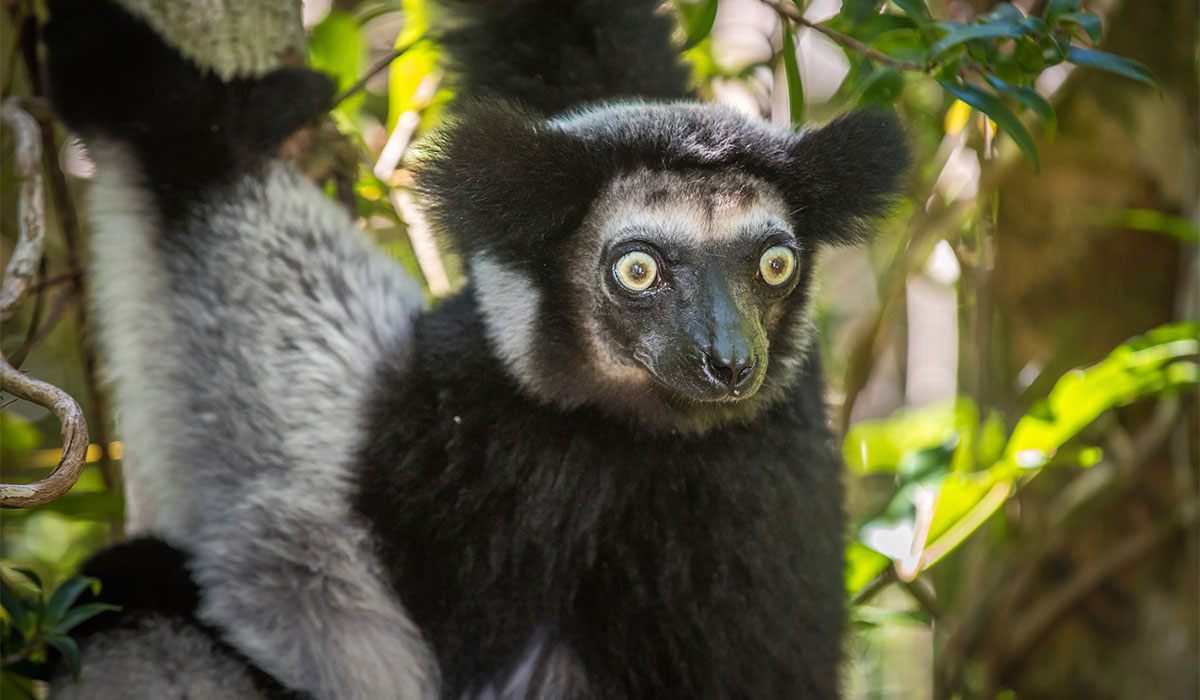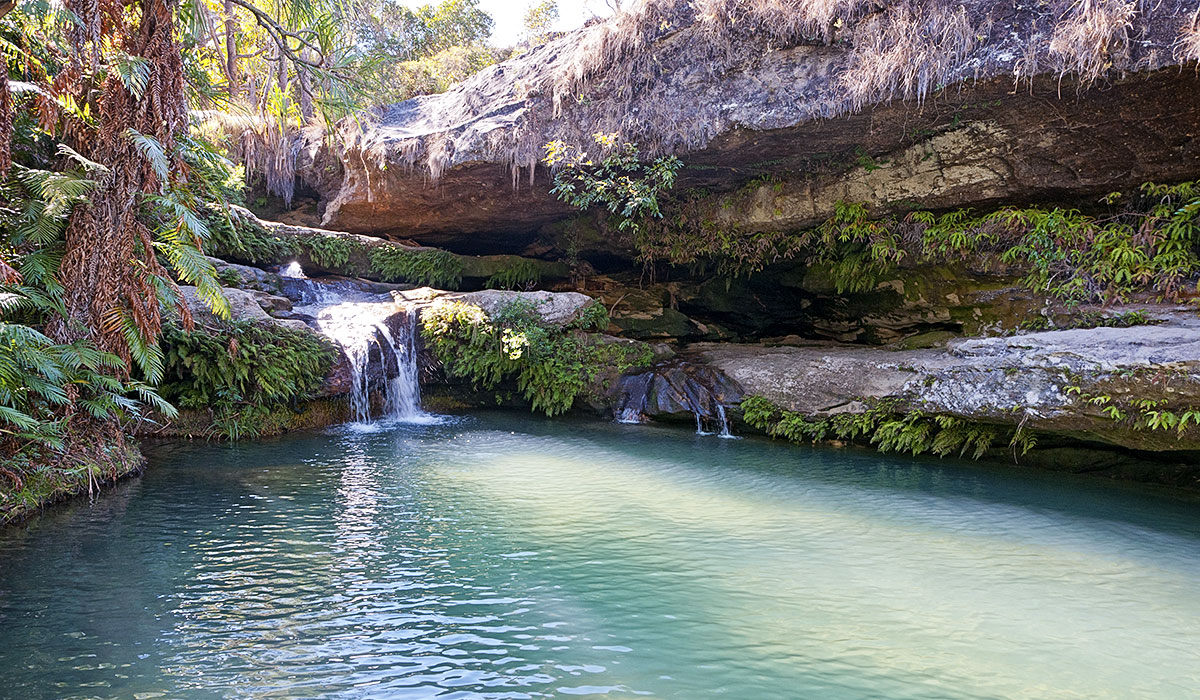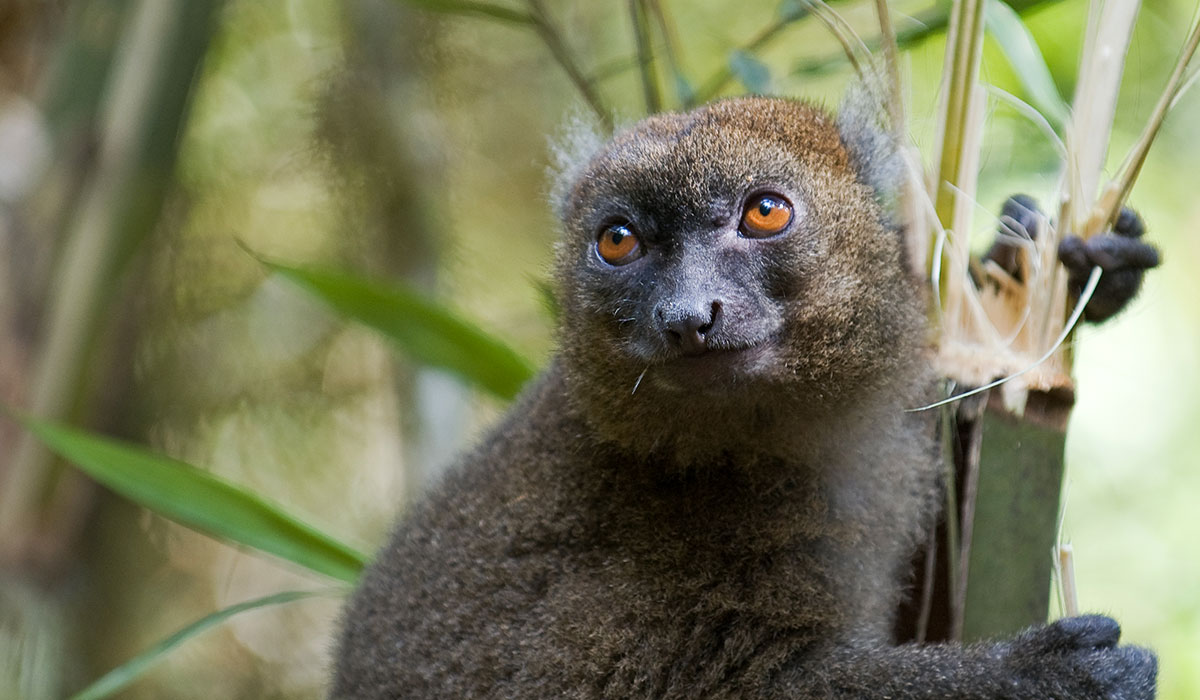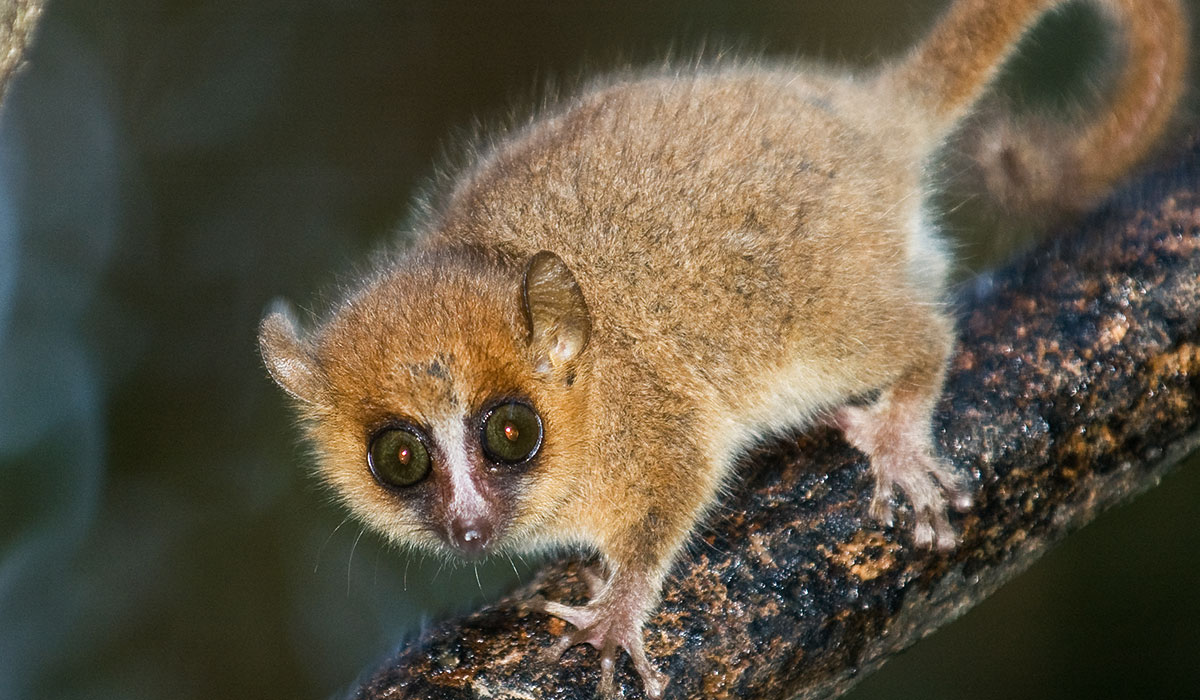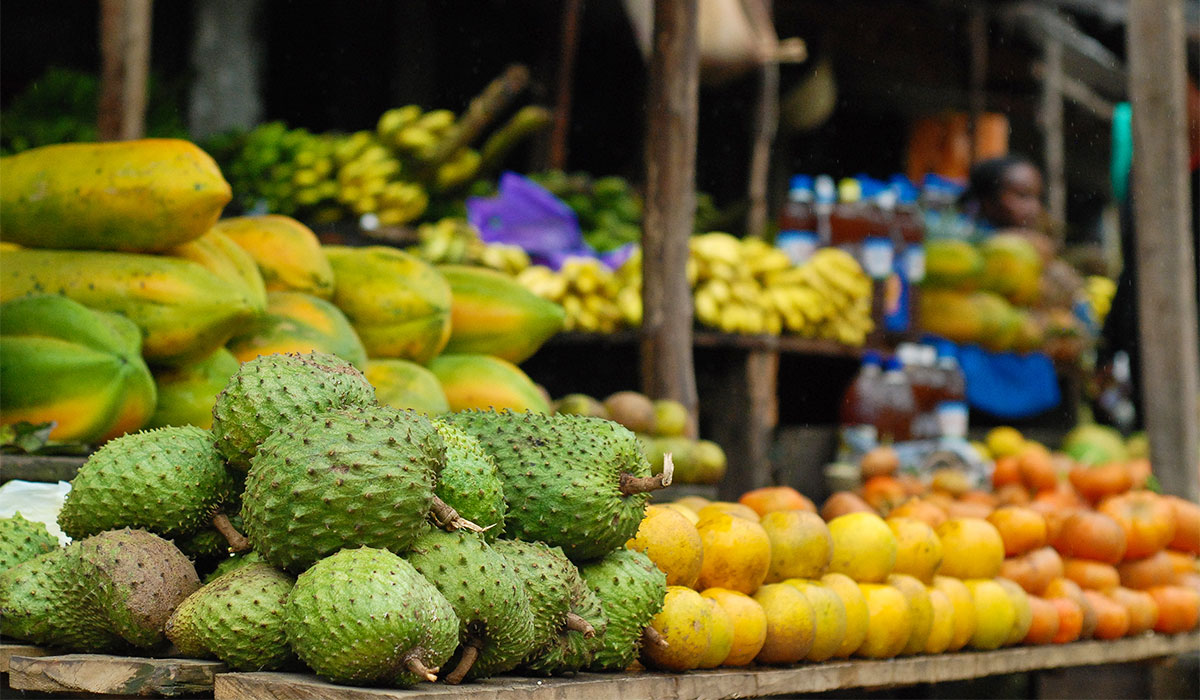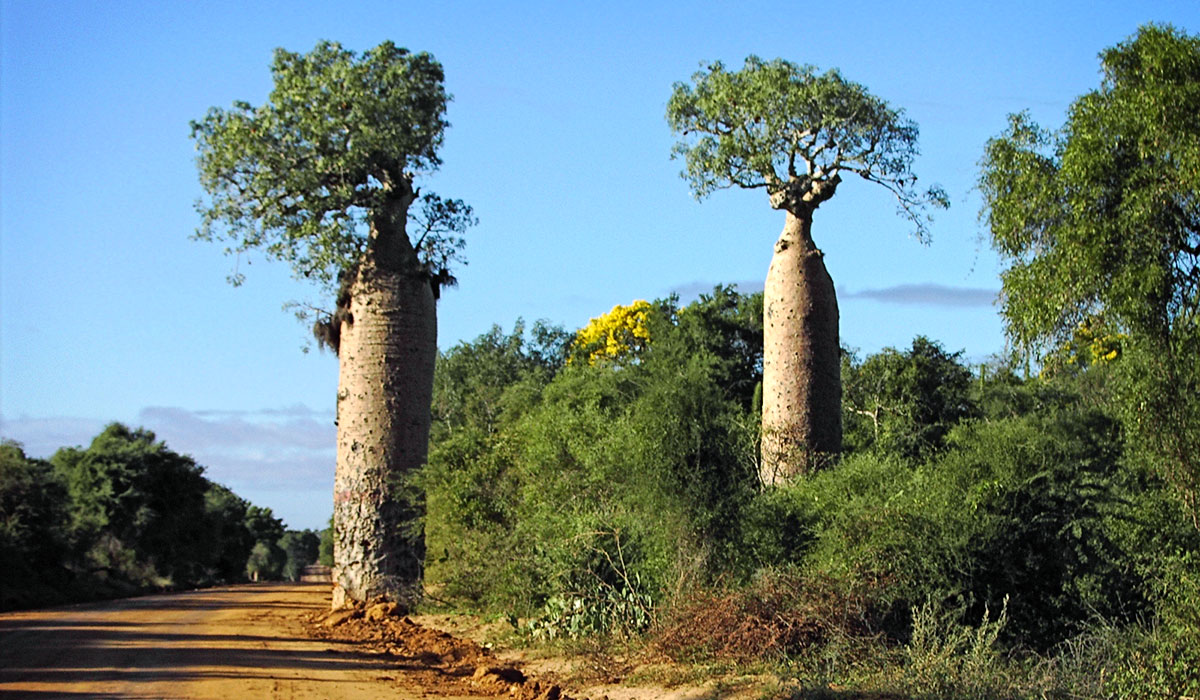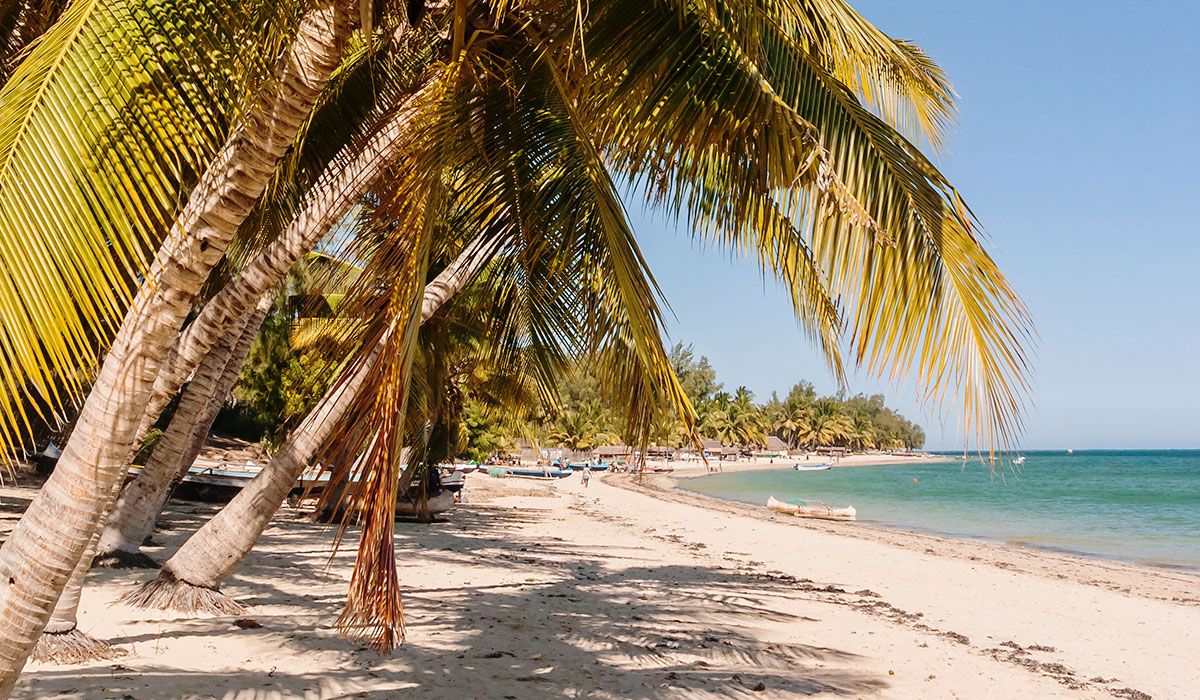Day 1 Arrive Antananarivo-Andasibe
Welcome to Madagascar! After a short briefing, we will drive to Andasibe through the green and luxuriant vegetation of the east. This first step brings us to a very humid part of the country with many primary forests and lakes. Along the way we will see Merina villages in the rocky mountains. Arrive in Andasibe early this evening. After time to check-in, we will leave on a night walk in the area of Andasibe to observe night active lemurs and other nocturnal animals.
Day 2 Andasibe
Our day starts in the Special Reserve of Andasibe to see the Indri Indri, the largest lemurs on the island. Andasibe Reserve is home to endemic fauna and flora including a wide variety of orchids, canopy, and endemic animals like chameleons, tenrecs, and many birds. We will have time to admire the beautiful orchids as we walk through the orchid park. Later this afternoon, a visit to the nearby Andasibe village, which is typical of the Betsimisaraka (�The-Many-Inseparables�) community will give us a look into the way of life of the local people. This is the second largest tribe on the island who are known to cultivate rice and live mainly off the forest.
Day 3 Andasibe-Antsirabe
We drive back to Tana, and head south to Antsirabe, across the highland landscape with its beautiful rice fields on display. The spectacular eroded hills called �lavaka� remind us of the Far East with its rice fields and green landscape with vegetables and fruit trees. We stop in Ambatolampy for a quick visit to this huge agricultural city, also recognized as a source of aluminium. We reach Antsirabe early this evening. �The place of salt� is an elegant city and known as the center of the beer industry - we can smell the Star Brewery as we enter the town! Founded by Norwegians in 1856, it is the only place which really feels and looks like a European city. It has a temperate climate and therefore fruit and vegetables which grow in colder climates, are found in Antsirabe.
Day 4 Antsirabe-Ranomafana National Park
After breakfast we drive to Ambositra, the centre of Madagascar's wood carving industry. The highlands are characterized by its architecture: The houses are made with ornately carved wooden balconies and shutters with bright colors. Further on we pass the �le col de tapia�, a type of tree resistant to bush fires. The landscape is still dominated by rice fields, pine forests, eucalyptus trees and rocky mountains.
Day 5 Ranomafana National Park
The approximately 40,000 ha of Parc National de Ranomafana with its rain forest covered hills and abundant wildlife, has long been considered one of Madagascar�s highlights. Altitudes in the park range from 800 m to 1200 m and, in addition to its densely forested hills, Ranomafana�s terrain is characterized by numerous small streams which plummet down to the beautiful Namorona River. Although much of the region has been logged, the easternmost part of the park retains relatively large areas of primary forest. You will go for long walks in the National Park spotting some of the lemurs, chameleons and other animals.
Day 6 Fianarantsoa � Isalo
Returning on the road we came on, we leave Ranomafana and pass Fianarantsoa �the city where one learns good things�. It is the gate to the South, the capital of the Betsileo tribes and the center of the catholic religion. Continuing south, our first stop is Ambalavao, the center of the wine industry. Madagascar's climate is not the best for grape vines, but the wine tradition was left by the monks and priests who lived in Fianarantsoa. We will sample some local wine and also visit the �Anteimoro Paper Factory� which is a vestige of the Arabian civilization on the island. We continue to Ihosy the capital of the Bara tribes, who are shepherds of Zebu, and further on pass through the mountain chain of Andringitra, which serves as a transition between the dry south and green highlands with its famous �3 hillocks� and its huge �archbishop's cape�. Along the way we will see from afar a spectacular huge granite dome with twin rock towers called �the gate of the south�, which in fact marks the end of the highland and the beginning of the south. The �Bishop's hat� is another noticeable, imposing formation and a sacred location for the local people - a place where their ancestors chose a collective suicide rather than to give in to the Merina tribes. We then pass through the huge �Plateaux de Horombe� with its very deep red soil, which reminds us of �the no man's land� and we arrive in Isalo.
Day 7 Isalo
Today, we will visit and hike in the Isalo National Park. The park covers an area of 81,540 ha, comprising of the entire stretch of the Isalo massif. This huge mountain is spectacular with its eroded sandstone elevations. After a 10 minute drive from Ranohira village, we park our car and begin the walk to the natural Swimming Pool. Along the way we will see vegetation like Uapaca bojeri, Pachypodium rosulatum or �elephant's foot� and Aloe isaloensis, a native species of aloe endemic to Isalo.
The eroded mountains also served as a place where the Bara kept their dead before they could bury them in their actual tombs. We start our climb and reach the massif, where we will have a spectacular view of the huge sandstone mountains with its beautiful colors and its strange and battered formations creating many different images like �the tortoise�, �the masks� and �the crocodiles�. We see small streams of water, and rivers which are marked by lines of brilliant green, generally made up of numerous Pandanus pulcher and the delicate, slim-stemmed, feathery leaved palm Chrysalidocarpus isaloensis. Along the way, there may be sifakas, brown lemurs and ring-tailed lemurs, as well as fifty-five species of birds, lizards and snakes. After about 1� hours, we reach the swimming pool, with its crystal clear water - a great reward after a long and very hot walk.
Day 8 Isalo to Ifaty
After breakfast, we continue to Tul�ar, the terminal of the National Road N� 7. This part of our journey brings us to new scenery among the dry forests of the west and the spiny desert of the south. On the way, we admire the different �Mahafaly tombs� and the �Antandroy tombs�. After a short visit of Tul�ar we drive to Ifaty, which lies about 27 km from Tul�ar. Due to the bad condition of the road, it will take us about 2� hours to reach Ifaty, the driest part of the country. Situated in the Deep South, the landscape is dominated by the cactus-like, spiny forest of different euphorbiaceae and didieraceae. We will cross the dry and sandy soil where the local people battle to find drinking water. Mangrove trees line the coast alternated by Vezo communities which earn their living from fishing. We will see many small pirogues with men who go out fishing twice a day, while children and women wait on the coast to collect the fish before taking them to Tul�ar for sale.
Day 9 Ifaty
Ifaty lies on the beach. It is therefore an ideal place for diving and snorkelling and a popular place for birdwatchers. Here you can also experience the Vezo fishermen's life. Many excursions are possible on this day of leisure. Visit the �Reserve Domergue�, a communal conservation area where one will see two kinds of baobabs, spiny bush, reptiles like �boa madagascariensis�, geckos and the �chameleon parsoni�, which is one of the largest chameleons in the world. You can also take a boat trip to see whales. From July to mid September, whales come to the cool seas of Madagascar to give birth to their young. It is a spectacular experience, and it is possible to see the whales very near to the boat. Situated in the largest lagoon of the country, Ifaty is also protected by a large coral reef, which makes it an ideal place for diving and snorkelling. In the afternoon we can walk to the village of Mangily to visit a local school and experience the Vezo fishermen's way of life, especially as they return from fishing.
Day 10 Ifaty-Tul�ar-Tana
We are up early this morning for the flight to Tana (Antananarivo). After check-in at the hotel, you have the afternoon free to explore and to do some sightseeing. The capital of Madagascar is also called the �City of Thousands� and it is where the first King started to unify the different kingdoms of the island. Tana was built in three stages: The high city, the first area occupied during the regal period where the old queen's palace is situated; the mid-city, where all the chic boutiques of the capital are found; and then the low city, which is the commercial area of the town. Walk from the high city to see the Rova, the queen's palace, and the house of the first minister during these days, which is now a museum. All of these were built by Frenchman Jean Laborde during the royal period. The mid-city, or the administration area, ends at the Rainiharo tombs and the lower town is situated in the main avenue called �L'avenue de l'independence� dominated by the railway station.
Day 11 Tana-Depart
Your amazing exploration of Madagascar comes to an end today as you are transferred to the airport for your flight home.
Welcome to Madagascar! After a short briefing, we will drive to Andasibe through the green and luxuriant vegetation of the east. This first step brings us to a very humid part of the country with many primary forests and lakes. Along the way we will see Merina villages in the rocky mountains. Arrive in Andasibe early this evening. After time to check-in, we will leave on a night walk in the area of Andasibe to observe night active lemurs and other nocturnal animals.
Accommodation Choices
Value Plus
Andasibe: Grace Lodge
Antananarivo (Tana): Residence Lapasoa
Antsirabe: Chambres du Voyageur
Ifaty: Hotel de la Plage
Isalo: Isalo Ranch
Ranomafana National Park: CentrestFirst Plus
Andasibe: Andasibe Hotel
Antananarivo (Tana): Hotel Carlton
Antsirabe: Vatolahy Hotel
Isalo: Jardin du Roy
Ranomafana National Park: Setam Lodge
Day 2 Andasibe
Our day starts in the Special Reserve of Andasibe to see the Indri Indri, the largest lemurs on the island. Andasibe Reserve is home to endemic fauna and flora including a wide variety of orchids, canopy, and endemic animals like chameleons, tenrecs, and many birds. We will have time to admire the beautiful orchids as we walk through the orchid park. Later this afternoon, a visit to the nearby Andasibe village, which is typical of the Betsimisaraka (�The-Many-Inseparables�) community will give us a look into the way of life of the local people. This is the second largest tribe on the island who are known to cultivate rice and live mainly off the forest.
Accommodation Choices
Value Plus
Andasibe: Grace Lodge
Antananarivo (Tana): Residence Lapasoa
Antsirabe: Chambres du Voyageur
Ifaty: Hotel de la Plage
Isalo: Isalo Ranch
Ranomafana National Park: CentrestFirst Plus
Andasibe: Andasibe Hotel
Antananarivo (Tana): Hotel Carlton
Antsirabe: Vatolahy Hotel
Isalo: Jardin du Roy
Ranomafana National Park: Setam Lodge
Day 3 Andasibe-Antsirabe
We drive back to Tana, and head south to Antsirabe, across the highland landscape with its beautiful rice fields on display. The spectacular eroded hills called �lavaka� remind us of the Far East with its rice fields and green landscape with vegetables and fruit trees. We stop in Ambatolampy for a quick visit to this huge agricultural city, also recognized as a source of aluminium. We reach Antsirabe early this evening. �The place of salt� is an elegant city and known as the center of the beer industry - we can smell the Star Brewery as we enter the town! Founded by Norwegians in 1856, it is the only place which really feels and looks like a European city. It has a temperate climate and therefore fruit and vegetables which grow in colder climates, are found in Antsirabe.
Accommodation Choices
Value Plus
Andasibe: Grace Lodge
Antananarivo (Tana): Residence Lapasoa
Antsirabe: Chambres du Voyageur
Ifaty: Hotel de la Plage
Isalo: Isalo Ranch
Ranomafana National Park: CentrestFirst Plus
Andasibe: Andasibe Hotel
Antananarivo (Tana): Hotel Carlton
Antsirabe: Vatolahy Hotel
Isalo: Jardin du Roy
Ranomafana National Park: Setam Lodge
Day 4 Antsirabe-Ranomafana National Park
After breakfast we drive to Ambositra, the centre of Madagascar's wood carving industry. The highlands are characterized by its architecture: The houses are made with ornately carved wooden balconies and shutters with bright colors. Further on we pass the �le col de tapia�, a type of tree resistant to bush fires. The landscape is still dominated by rice fields, pine forests, eucalyptus trees and rocky mountains.
Accommodation Choices
Value Plus
Andasibe: Grace Lodge
Antananarivo (Tana): Residence Lapasoa
Antsirabe: Chambres du Voyageur
Ifaty: Hotel de la Plage
Isalo: Isalo Ranch
Ranomafana National Park: CentrestFirst Plus
Andasibe: Andasibe Hotel
Antananarivo (Tana): Hotel Carlton
Antsirabe: Vatolahy Hotel
Isalo: Jardin du Roy
Ranomafana National Park: Setam Lodge
Day 5 Ranomafana National Park
The approximately 40,000 ha of Parc National de Ranomafana with its rain forest covered hills and abundant wildlife, has long been considered one of Madagascar�s highlights. Altitudes in the park range from 800 m to 1200 m and, in addition to its densely forested hills, Ranomafana�s terrain is characterized by numerous small streams which plummet down to the beautiful Namorona River. Although much of the region has been logged, the easternmost part of the park retains relatively large areas of primary forest. You will go for long walks in the National Park spotting some of the lemurs, chameleons and other animals.
Accommodation Choices
Value Plus
Andasibe: Grace Lodge
Antananarivo (Tana): Residence Lapasoa
Antsirabe: Chambres du Voyageur
Ifaty: Hotel de la Plage
Isalo: Isalo Ranch
Ranomafana National Park: CentrestFirst Plus
Andasibe: Andasibe Hotel
Antananarivo (Tana): Hotel Carlton
Antsirabe: Vatolahy Hotel
Isalo: Jardin du Roy
Ranomafana National Park: Setam Lodge
Day 6 Fianarantsoa � Isalo
Returning on the road we came on, we leave Ranomafana and pass Fianarantsoa �the city where one learns good things�. It is the gate to the South, the capital of the Betsileo tribes and the center of the catholic religion. Continuing south, our first stop is Ambalavao, the center of the wine industry. Madagascar's climate is not the best for grape vines, but the wine tradition was left by the monks and priests who lived in Fianarantsoa. We will sample some local wine and also visit the �Anteimoro Paper Factory� which is a vestige of the Arabian civilization on the island. We continue to Ihosy the capital of the Bara tribes, who are shepherds of Zebu, and further on pass through the mountain chain of Andringitra, which serves as a transition between the dry south and green highlands with its famous �3 hillocks� and its huge �archbishop's cape�. Along the way we will see from afar a spectacular huge granite dome with twin rock towers called �the gate of the south�, which in fact marks the end of the highland and the beginning of the south. The �Bishop's hat� is another noticeable, imposing formation and a sacred location for the local people - a place where their ancestors chose a collective suicide rather than to give in to the Merina tribes. We then pass through the huge �Plateaux de Horombe� with its very deep red soil, which reminds us of �the no man's land� and we arrive in Isalo.
Accommodation Choices
Value Plus
Andasibe: Grace Lodge
Antananarivo (Tana): Residence Lapasoa
Antsirabe: Chambres du Voyageur
Ifaty: Hotel de la Plage
Isalo: Isalo Ranch
Ranomafana National Park: CentrestFirst Plus
Andasibe: Andasibe Hotel
Antananarivo (Tana): Hotel Carlton
Antsirabe: Vatolahy Hotel
Isalo: Jardin du Roy
Ranomafana National Park: Setam Lodge
Day 7 Isalo
Today, we will visit and hike in the Isalo National Park. The park covers an area of 81,540 ha, comprising of the entire stretch of the Isalo massif. This huge mountain is spectacular with its eroded sandstone elevations. After a 10 minute drive from Ranohira village, we park our car and begin the walk to the natural Swimming Pool. Along the way we will see vegetation like Uapaca bojeri, Pachypodium rosulatum or �elephant's foot� and Aloe isaloensis, a native species of aloe endemic to Isalo.
The eroded mountains also served as a place where the Bara kept their dead before they could bury them in their actual tombs. We start our climb and reach the massif, where we will have a spectacular view of the huge sandstone mountains with its beautiful colors and its strange and battered formations creating many different images like �the tortoise�, �the masks� and �the crocodiles�. We see small streams of water, and rivers which are marked by lines of brilliant green, generally made up of numerous Pandanus pulcher and the delicate, slim-stemmed, feathery leaved palm Chrysalidocarpus isaloensis. Along the way, there may be sifakas, brown lemurs and ring-tailed lemurs, as well as fifty-five species of birds, lizards and snakes. After about 1� hours, we reach the swimming pool, with its crystal clear water - a great reward after a long and very hot walk.
Accommodation Choices
Value Plus
Andasibe: Grace Lodge
Antananarivo (Tana): Residence Lapasoa
Antsirabe: Chambres du Voyageur
Ifaty: Hotel de la Plage
Isalo: Isalo Ranch
Ranomafana National Park: CentrestFirst Plus
Andasibe: Andasibe Hotel
Antananarivo (Tana): Hotel Carlton
Antsirabe: Vatolahy Hotel
Isalo: Jardin du Roy
Ranomafana National Park: Setam Lodge
Day 8 Isalo to Ifaty
After breakfast, we continue to Tul�ar, the terminal of the National Road N� 7. This part of our journey brings us to new scenery among the dry forests of the west and the spiny desert of the south. On the way, we admire the different �Mahafaly tombs� and the �Antandroy tombs�. After a short visit of Tul�ar we drive to Ifaty, which lies about 27 km from Tul�ar. Due to the bad condition of the road, it will take us about 2� hours to reach Ifaty, the driest part of the country. Situated in the Deep South, the landscape is dominated by the cactus-like, spiny forest of different euphorbiaceae and didieraceae. We will cross the dry and sandy soil where the local people battle to find drinking water. Mangrove trees line the coast alternated by Vezo communities which earn their living from fishing. We will see many small pirogues with men who go out fishing twice a day, while children and women wait on the coast to collect the fish before taking them to Tul�ar for sale.
Accommodation Choices
Value Plus
Andasibe: Grace Lodge
Antananarivo (Tana): Residence Lapasoa
Antsirabe: Chambres du Voyageur
Ifaty: Hotel de la Plage
Isalo: Isalo Ranch
Ranomafana National Park: CentrestFirst Plus
Andasibe: Andasibe Hotel
Antananarivo (Tana): Hotel Carlton
Antsirabe: Vatolahy Hotel
Isalo: Jardin du Roy
Ranomafana National Park: Setam Lodge
Day 9 Ifaty
Ifaty lies on the beach. It is therefore an ideal place for diving and snorkelling and a popular place for birdwatchers. Here you can also experience the Vezo fishermen's life. Many excursions are possible on this day of leisure. Visit the �Reserve Domergue�, a communal conservation area where one will see two kinds of baobabs, spiny bush, reptiles like �boa madagascariensis�, geckos and the �chameleon parsoni�, which is one of the largest chameleons in the world. You can also take a boat trip to see whales. From July to mid September, whales come to the cool seas of Madagascar to give birth to their young. It is a spectacular experience, and it is possible to see the whales very near to the boat. Situated in the largest lagoon of the country, Ifaty is also protected by a large coral reef, which makes it an ideal place for diving and snorkelling. In the afternoon we can walk to the village of Mangily to visit a local school and experience the Vezo fishermen's way of life, especially as they return from fishing.
Accommodation Choices
Value Plus
Andasibe: Grace Lodge
Antananarivo (Tana): Residence Lapasoa
Antsirabe: Chambres du Voyageur
Ifaty: Hotel de la Plage
Isalo: Isalo Ranch
Ranomafana National Park: CentrestFirst Plus
Andasibe: Andasibe Hotel
Antananarivo (Tana): Hotel Carlton
Antsirabe: Vatolahy Hotel
Isalo: Jardin du Roy
Ranomafana National Park: Setam Lodge
Day 10 Ifaty-Tul�ar-Tana
We are up early this morning for the flight to Tana (Antananarivo). After check-in at the hotel, you have the afternoon free to explore and to do some sightseeing. The capital of Madagascar is also called the �City of Thousands� and it is where the first King started to unify the different kingdoms of the island. Tana was built in three stages: The high city, the first area occupied during the regal period where the old queen's palace is situated; the mid-city, where all the chic boutiques of the capital are found; and then the low city, which is the commercial area of the town. Walk from the high city to see the Rova, the queen's palace, and the house of the first minister during these days, which is now a museum. All of these were built by Frenchman Jean Laborde during the royal period. The mid-city, or the administration area, ends at the Rainiharo tombs and the lower town is situated in the main avenue called �L'avenue de l'independence� dominated by the railway station.
Accommodation Choices
Value Plus
Andasibe: Grace Lodge
Antananarivo (Tana): Residence Lapasoa
Antsirabe: Chambres du Voyageur
Ifaty: Hotel de la Plage
Isalo: Isalo Ranch
Ranomafana National Park: CentrestFirst Plus
Andasibe: Andasibe Hotel
Antananarivo (Tana): Hotel Carlton
Antsirabe: Vatolahy Hotel
Isalo: Jardin du Roy
Ranomafana National Park: Setam Lodge
Day 11 Tana-Depart
Your amazing exploration of Madagascar comes to an end today as you are transferred to the airport for your flight home.


